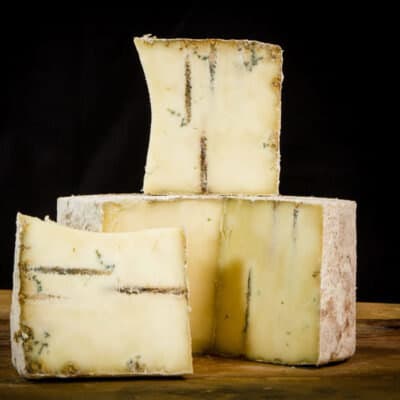Dunbarton Blue – Cheese Course
by Max Shrem, Posted Apr 6th 2010 @ 5:00PM
No cheese better captures both the earthy, nutty taste of cheddar and the piquant kick of a blue cheese like Dunbarton Blue from Roelli Cheese Company in Shullsburg, Wis. This cheese hybrid is not the result of mere coincidence. It’s the brilliant effect of ever so carefully applying several different cheese-making techniques – “cheddaring,” piercing the cheese and above all cave-aging the cheese. To find out more about how all these procedures create Dunbarton Blue, we spoke to its creator, Chris Roelli.
“I set out to create a young to medium aged farmstead cheddar with a hint of blue,” explains Roelli. To achieve this goal, he begins with collecting high-quality fresh milk from a single dairy. According to Roelli, selecting the milk is one of the most important parts of the cheese making process. The blue veins are created by introducing blue mold spores to the already flavorful milk. But, that’s not the only way blue is added to the cheese.
After turning and stacking loaves of curds (a process known as cheddaring), Roelli pierces the wheels to allow air to flow through the cheeses as they age, encouraging molds to develop. “I do not want the entire wheel to be covered in blue veins, and so, I pierce the center of the cheese rather than the entire wheel” says Roelli. “In fact, when the cheese is sliced you can even see where the cheese has been punctured based on the blue lines appearing in the center.” Rather than produce a dominantly blue cheese, he creates cheddar with blue veins as an accessory to the already earthy flavor that melts on the palate.
Roelli spends four months aging the wheels in a cave surrounded by earth at 90 percent humidity. “Along with its milk, the cave-aging is responsible for giving Dunbarton Blue its earthy, buttery, milky, nice clean taste,” says Roelli. The atmosphere of the cave has a lot to do with the flavor development. Indeed, it’s the high humidity that promotes certain favorable molds to develop. To increase the humidity, Roelli wets the floor of the cave every day.
During the affinage, Dunbarton Blue requires a lot of care and attention. Since this process is so labor intensive, Roelli produces only 35 wheels per week, a low number considering its high demand around the country, from specialty food stores in New York City, like Stinky Bklyn, to San Francisco’s Rainbow Grocery. For the first few weeks, the cheeses are turned every other day, and as the aging progresses, the cheeses are turned just once week. The rotation guarantees even draining of the remaining whey.
After four months in the cave, Dunbarton Blue emerges with a firm texture similar to British cheddar. Its earthy rustic taste is even reminiscent of Montgomery’s Cheddar but with blue veins. Roeilli pays tribute to the cheese’s English predecessors by giving the cheese an English name. It’s also the name of a neighboring township, one mile from the cheese factory. In this way, the name seems to bridge two worlds of cheese – “traditional” cheddars with innovative unique American alternatives.









